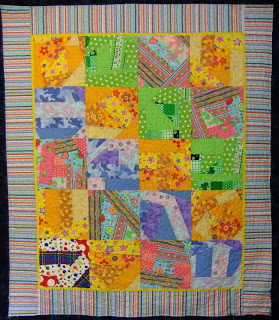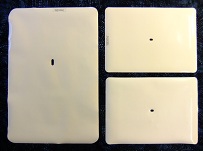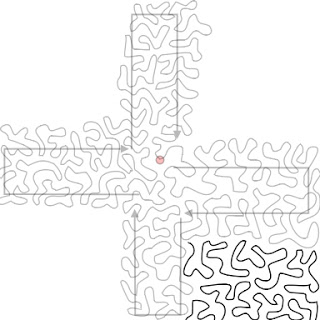Quilt Along #9 – Moving the Quilt
Last week I shared a tutorial about quilting a real quilt on your machine and showed a video mostly showing the movement of my hands as I quilted this Crazy Pepper Quilt:
 Many quilters requested a second video, this time showing the whole quilt from a different angle to better understand how the quilt moves on the machine and how I deal with the bulk of it at any given time.
Many quilters requested a second video, this time showing the whole quilt from a different angle to better understand how the quilt moves on the machine and how I deal with the bulk of it at any given time.
So that’s what I’ve done! I quilted another UFO quilt this week, this time a quilt that’s been fully basted and ready to go for more than a year. This quilt is around the same size as Crazy Pepper, so it’s a good example of how to move, reposition, and rotate your quilt on your home machine.
There are several things to note with this video and the first is it was sped up 8 times the normal speed so I could show you the entire process of the quilt being broken down into quadrants, then a single quadrant being quilted (the other 3 were quilted the same way with rows of quilting).
The second major note is my neck angle through most of this video. All I have to say is it explains a lot about why I’ve struggled with both intense headaches and neck issues for the last year.
As for a solution – if my chair had been lower, I might not have had to angle my neck in that way. However, if the chair is too low then your shoulders will come up to get over the quilt and you’ll end up with a back ache, not a neck ache.
I’m still working out a better solution. Of course, not all machines are going to be so difficult to see around. One of the few annoying things about the Janome Horizon is how big and clunky the top area above the needle is. The front comes out quite far, so most of the time I’m bending my neck down just to see around the machine body to see where I’ve stitched the previous row.
So really it’s a toss up between lowering your chair considerably, which will bring your arms and shoulders up, and may hurt your back, or you can leave your chair up higher and just deal with constant headaches and neck aches. Personally, I’m ready for my back to hurt!
Now let’s move on to actually moving the quilt on the machine and table. For this, I was using a Free Motion Glider.
 These sliders are slick Teflon sheets designed to make your quilt move easier over the surface of your machine. If you can fit one, a Queen Supreme is most beneficial because it takes up more room, helping the quilt move easier over a larger area.
These sliders are slick Teflon sheets designed to make your quilt move easier over the surface of your machine. If you can fit one, a Queen Supreme is most beneficial because it takes up more room, helping the quilt move easier over a larger area.
Even if your arm isn’t quite big enough, you can cut both sliders down with scissors to make them fit to your machine.
One thing to note is that these tools are very, very, very, VERY delicate. Yes, you can trim them down with scissors, so yes, you can also sew through them!
The best advice for using a slider for the first time is to TAPE IT DOWN.
Until you’re used to the feeling of having a slider under your quilt, you won’t know the telltale signs that you’re stitching through it until it’s too late. Tape the slider down on the corners so there’s no chance it will move or shift while you’re quilting.
The slider attaches to your machine with a pink slightly grippy side. It’s not like a sticker, so it won’t leave a residue or gummy place on your machine, however the grippiness of this tool is reduced every time you take it off because lint clings to it.
It’s a good idea that every time you put the slider back on your machine to free motion, take a second to rinse it off at the sink before you get started. Pat it dry with paper towels and you’ll find the grippiness is much better, but still – it’s always a good idea to TAPE IT DOWN.
A lot of quilters ask about using a slider with the feed dogs UP as I advise. Yes, I’ll be honest, the slider does get chewed a bit right around the feed dogs.
So far I’ve never found this detrimental to either the slider, my quilts, or my machine. The area does get worn with use, but that doesn’t mean you have to stop using it.
You can always cut out the center of the slider if the area gets really worn.
Instead of using this slider for free motion quilting, I use it for times I need to use the feed dogs, like binding, where I have the whole quilt on the machine and a lot of weight and bulk to deal with. Having the slider under the quilt makes it move and slide around much easier, so I can continue using this tool effectively, even if the center gets worn out.
So the Queen Supreme Slider definitely helps the quilt move and glide more easily over the table and machine. Another aid for this job are Machingers Quilting Gloves which increase your grip and control over the quilt.
Finally the last thing that’s really helped recently has been the new Ikea tables I just installed. These white tables around my machine have a slick coated surface that make them much easier to move the quilt over.
Now that we’ve covered ways to make moving the quilt easier, now let’s talk about what we’re actually stitching while this is going on. Remember back to Quilt Along #2: Quilting in rows – I showed an example of Quadrant Quilting. This is my preferred method for covering a quilt with one single design.
When quilting a large quilt with 1 design, I go a step further and break the entire quilt down into 4 quadrants with rows of a design first:
 Depending on how big the design and the quilt is, this process can take around 1-2 hours. Once this part is knocked out, all you have to do is fill each quadrant which takes around 30 minutes each:
Depending on how big the design and the quilt is, this process can take around 1-2 hours. Once this part is knocked out, all you have to do is fill each quadrant which takes around 30 minutes each:

It’s a good idea to play with this idea and experiment with different angles and directions before you settle on the one that works best for you. The biggest key with this is:
Work from the center to the borders!
I received a comment from Daryl last week that perfectly illustrates why we need to work from the center to the borders of a quilt in a logical way:
My mother hand pieced a twin size Grandmother’s Flower Garden quilt that was intended for my younger sister (when she was a teenager….Several years ago Mom gave that quilt to me to finish….So I too did a meandering quilt stitch like you showed on your video only my meandering was closer together. All was going well at first, but then I ended up in a spot where it puckered and I mean really puckered so bad that the fabric had to fold over on itself. Well 1/3 of the quilt was quilted and I was NOT going to rip out everything. So I had to quilt the puckers in. How could I have avoided the puckers? I started from the middle of the quilt and quilted out, but then the puckers occurred when I was quilting where 2 areas of quilting came together and that’s where the major puckers where that I couldn’t flatten it out.
In this situation, it’s very hard to know what happened, Daryl, because I haven’t seen the quilt or how you tackled quilting it.
However, if you’re quilting from the middle to the borders, there shouldn’t be an area where two massive sections of quilting meet up to create puckers like you’ve described.
I don’t think you did anything wrong in this case, because the quilt is quilted and can now be used, which is much better than being a UFO. My one suggestion would be to try knocking out the quilt in a more logical way next time and use a thinner batting. Chances are some things were shifting thanks to the puffy batting you mentioned using. Also a dense stippling / meandering is far less forgiving than a bigger scale design. Next time try stitching the design bigger as well.
Has this ever happened to you?
The best way to avoid pleats and puckers is to use Quadrant Quilting. At any given time, you can smooth out excess fabric and potential puckers because all the open edges remain open so the fabric has somewhere to GO at any given time. When you lock the edges of a quilt, you essentially slam the door on your ability to smooth out fabric and potential pleats.
So now that you have seen how a real quilt is moved, repositioned, and rotated while it’s quilted, it’s time you get on your sewing machine and try it!
Now just in case you’re blind with boredom over stitching Stippling on a large scale, don’t worry! Next week we’re going to stitch it up a notch and start working on our first wholecloth quilt!
Now let’s link up all your progress from last week:
Instructions for Linking Up Your Blog:
1. Write your blog post. Publish it on your blog.
2. Copy the link of the specific blog post. This is not just the link to your blog itself (www.freemotionquilting.blogspot.com), but the link to the specific post: https://freemotionproject.com/2012/01/quilt-along-2-quilting-in-rows.html
3. Click the blue link up button above and paste your link into the box.
Keep in mind that you’re posting your progress from LAST week on THIS week’s post. This way you have time to watch the lesson, play with the ideas, then post your progress to the next quilt along. I hope that makes sense!
As always, any questions you have, please post them in the comments below or on your blog and I’ll answer 5 tomorrow on Question Thursday.
Time to shut up and go quilt!
Leah

I did my all-over meander quilting on my lap-size quilt and really kept in mind the 'quilting in rows' idea (I already used quadrants) and I must say the quilting went along quite smoothly and I broke thread MUCH less often than in the past! (Yay!) It took me about 3 hours or so – which made me feel I was on track based on what you'd said! Thanks again! I would linky but I'm not posting about this quilt until the end of March – but trust me that my fmq has greatly improved! Some really nice stitches and I only crossed a line once when the dog barked and startled me! (I swear I was seeing meandering lines in my sleep!) I definitely know what you mean about the large top on the Horizon and having to peek under it! lol!
I really appreciate these posts, Leah. Found a few hints to better my quilting.
I am quilting a REAL quilt! I find my quilting has improved so much since I joined this Quilt Along. I've learned a great deal. Thank you, Leah!
On my blog I've shown my efforts in quilting a REAL quilt. I'm using a quilt-as-you-go technique and I've posted this question for you on my blog:
How do I make sure the design continues onto the other parts of the quilt so it doesn't show that the quilt was quilted in four separate pieces?
Leah, what is your opinion of using silicon sprays for your quilting table to make the quilt slide smoothly?
Leah I have the same problem with visibility around the head of my Brother QC-1000. It is so bulky that I can't see around or behind it. One solution would be to get the Pfaff or Brother fast straight stitch machines which are much narrower (and fast). I bought a Sit-Down Tin Lizzie so I could see better.
Thank you for this quilt along series. I'm a beginner so you've set me up well to work on my first quilt. So far I've just done a bit of practicing on a quilt sandwich and I must say it's a bit frustrating not to have the needle up/down option on my machine, but I'm working around it and adjusting by making sure I lightly tap the foot pedal to make sure the needle is down before moving my hands.
Does the supreme slider work better than the acrylic extension tables? I just purchased an acrylic extension table and after spending $150 on it, the supreme slider would have to improve things in a big way for me to justify another expense. What are you thoughts/opinions regarding this?
Have you considered reorienting your sewing machine table so that the your machine is perpendicular to your body? It seems like there would be less to look around and with your ikea table your could reconfigure your workshop to provide similar working surface dimensions.
I have been following your posts for over a year now. I loved seeing all the designs but this series of posts have been what has made fmq finally approachable for me. And this video has been the most helpful of all. That wrestling with the quilt has been the hardest part. Thanks so much for putting this out there. Although I am not quilting along, I don't have that many quilts to quilt, I have learned more in the past month or so following along with you.
I covered my wooden sewing table with clear vinyl. I stapled it to the bottom. It was cheep and slick!
I love your quilt along and have learned much. Thanks for talking about the positioning of your chair, etc. and the need to take breaks every so often…I'm such a "get r done" kinda person…self-satisfaction…that I often forget to get some breaks in and have the sore neck and shoulders to prove it. Very important! Keep up the good work, you are awesome!
Blessings~
Cindy
I got distracted while watching this video by the chickens wandering around outside the window! Love your new set-up, Leah, and I suspect I'll be going to Ikea at some point. I've been wondering about the best table height, from an ergonomic and quilting point of view. At the moment I'm using a dining table, which feels a bit too high, especially as I'm quite short – any advice on deciding the best height for sewing table and chair?
I have the Janome Horizon as well and was looking for a way to remove some of that plastic around the needle and the take up lever. (I haven't figured it out yet) It does get in the way of seeing what is going on.
Leah, hmmm yes you're hurting your neck and probably would have to do something about it. I would also like to know how to fix it. Since, I noticed that while doing large scale stippling I was doing the exact same thing.
For week9, I'm not sure what we need to do other than make another quilt. Is this the basic requirement? I have a very tight space so really don't have much control over moving my quilt.
Thanks again for your insights!
Thank you for the table info – it was amazing the difference! No drag…I finished my Scrappy FMQ'ng…today. Now just need to do the scrappy border. http://www.thriftyideastoday.com/
have you considered propping up the front edge of your machine (maybe a couple of erasers?) so that you can actually see your needle … saw that hint somewhere and it was a lightbulb moment for me!
Leah: try moving your chair back 1-2 inches, it is amazing how much that little movement helps. The other thing, as you have discovered, is that the top of machines are BULKY. I sew on a Janome (currently the 8900), and that is the major reason I'm considering one of the sit-down longarms. They not only have space left to right, but the arm that comes over the the needle/head area is much higher, permitted greater visibility. These machines cost as much as a decent used car (sigh), which is hard when you are doing things like feeding your kids, but I'm saving! HTH, Sarah (SarahAnnSmith.com)